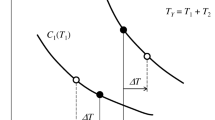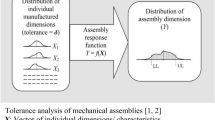Abstract
In mechanical assemblies, individual components are placed together to deliver a certain function. The performance, quality, and cost of the mechanical assembly are significantly affected by its tolerances. Toleranced dimensions inherently generate an uncertain environment in a mechanical assembly. This paper presents a proper method for tolerance analysis of mechanical assemblies with asymmetric tolerances based on an uncertainty model. This mathematical approach is based on fuzzy logic and tolerance accumulation models such as worst-case and root-sum-square methods. A fuzzy-based tolerance representation is developed to model uncertainty of tolerance components in the mechanical assemblies. According to this scheme, toleranced components are described as fuzzy numbers with their membership functions constructed using the statistical distributions of manufactured variables. In this way, the uncertainty of assembly requirements and accumulation of tolerances are represented in the form of fuzzy number. In this paper, a new factor, the fuzzy factor, is introduced that helps converting the membership functions into fuzzy intervals that can be used for modal interval analysis. Equations for estimation of percent contributions of individual tolerances are introduced in terms of uncertainty parameter. These equations yield percent contributions of upper and lower bounds of independent variables (manufactured dimensions) on the upper and lower bounds of dependent variables (assembly dimensions). The proposed method is applied to an example, and its results are discussed.
Similar content being viewed by others
References
Ngoi BKA, Ong CT (1998) Product and process dimensioning and tolerancing techniques. A state-of-the-art review. Int J Adv Manuf Technol 14:910–917
Scholz F (1995) Tolerance stack analysis methods. Research and Technology Boeing Information & Support Services, Boeing, Seattle, pp 1–44
Fortini ET (1967) Dimensioning for interchangeable manufacture. Industrial Press, New York
Evans DH (1975) Statistical tolerancing: the state of art. Part II: Methods for estimating moments. J Qual Technol 7(1):1–12
Roy U, Liu CR, Woo TC (1991) Review of dimensioning and tolerancing: representation and processing. Comput Aided Des 23(7):466–483
Greenwood WH, Chase KW (1988) Worst case tolerance analysis with nonlinear problems. J Eng Industry ASME 110:232–235
Greenwood WH, Chase KW (1990) Root sum squares tolerance analysis with nonlinear problems. J Eng Industry ASME 112:382–384
Movahhedy MR, Khodaygan S (2007) Tolerance analysis of mechanical assemblies with asymmetric tolerances. SAE 2007 Transactions J Mater Manuf 116:44
Wu W, Rao SS (2006) Fuzzy analysis of geometric tolerances using interval method. Proc IME C: J Mech Eng Sci 220(4):489–497
Celikyilmaz A, Türksen IB (2009) Modeling uncertainty with fuzzy logic with recent theory and applications. Springer, Berlin
Li HX, Yen VC (1995) Fuzzy sets and fuzzy decision-making. CRC Press, Boca Raton, FL
Moore RE (1966) Interval analysis. Prentice-Hall, Englewood Cliffs
Moore RE, Kearfott RB, Cloud MJ (2009) Introduction to interval analysis. Society for Industrial and Applied Mathematics, Philadelphia
Gardenes E, Sainz MA, Jorba L, Calm R, Estela R, Mielgo H, Trepat A (2001) Modal intervals. Reliab Comput 7(2):77–111
Popova ED (2001) Multiplication distributivity of proper and improper intervals. Reliab Comput 7(2):129–140
Wang Y (2008) Semantic tolerance modeling based on modal interval analysis. In: Proceedings of the international workshop on reliable engineering computing REC'08, Savannah, Georgia, pp 46–59, 20–22 February 2008
Chase KW, Gao J, Magleby SP (1997) Tolerance analysis of 2-D and 3-D mechanical assemblies with small kinematic adjustments. In: Zhang H-C (ed) Advanced tolerancing techniques. Wiley, New York, pp 103–137
Creveling CM, Wesley A (1997) Tolerance design: a handbook for developing optimal specifications. Longman, White Plains, NY
Civanlar MR, Trussell HJ (1986) Constructing membership functions using statistical data. Fuzzy Sets Syst 18(1):1–13
Rice J (1995) Mathematical statistics and data analysis, 2nd edn. Duxbury Press, North Scituate, MA
Mansoor EM (1963) The application of probability to tolerances used in engineering designs. Proc Inst Mech Eng 178(1):29–51
Bjørke Ø (1978) Computer aided tolerancing. Tapir Publishers, Norway
Henzold G (2006) Geometrical dimensioning and tolerancing for design, manufacturing and inspection: a handbook for geometrical product specification using ISO and ASME standards, 2nd edn. Elsevier, Amsterdam
Sleeper AD (2006) Design for six Sigma Statistics-59 tools for diagnosing and solving problems in DFSS initiatives. McGraw-Hill, USA
Hoyle MH (1973) Transformations: an introduction and a bibliography. Int Stat Rev 41(2):203–223
Author information
Authors and Affiliations
Corresponding author
Rights and permissions
About this article
Cite this article
Khodaygan, S., Movahhedy, M.R. Tolerance analysis of assemblies with asymmetric tolerances by unified uncertainty–accumulation model based on fuzzy logic. Int J Adv Manuf Technol 53, 777–788 (2011). https://doi.org/10.1007/s00170-010-2855-4
Received:
Accepted:
Published:
Issue Date:
DOI: https://doi.org/10.1007/s00170-010-2855-4




